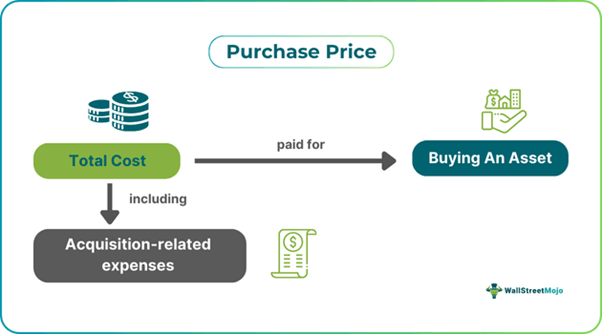Table of Contents
Purchase Price Meaning
Purchase Price refers to the total amount an individual or entity pays to purchase an asset. This cost of the asset includes all expenses related to its acquisition, including the commissions of sales as applicable. When the purchase price is calculated, it becomes the amount with respect to which gains and losses are assessed.

The asset involved could be an investment, a product, or even a mergers and acquisition deal. This price plays an important role in calculating depreciation, investment analysis, and determining tax implications. It enhances accountability and transparency in financial statements, reflecting the total price paid for a purchase, be it a product bought or a company acquired.
Key Takeaways
- The purchase price reflects the total cost, including acquisition-related expenses, that individuals or entities pay to acquire an asset.
- This price helps organizations with accurate valuation, taxation, and regulatory compliance.
- The formula applied in case of purchasing or acquiring a company can be written as follows: PP=Base PP + Cash− Indebtedness + (Net Working Capital−Working Capital Target)
- It represents the money paid to buy a company, usually adjusted for cash, debt, and working capital.
- The loan amount represents the total amount of loan borrowed by an entity or individual to fund operations or acquisitions.
- The loan amount represents the total amount of loan borrowed by an entity or individual to fund operations or acquisitions.
Purchase Price Explained
The purchase price represents the total amount of funds paid to buy a company, security, or asset. It involves elements like liabilities, working capital, fees, taxes, base price, and commissions. It acts as the ground for calculating capital losses or gains after the sale of the asset. In accounting, it depicts the economic value exchanged and acts as a pillar for accounting adjustments and purchase price allocation schedule. In a way, it acts as a true reflection of real asset valuation in business operations.
Purchase price accounting is crucial, specifically during the occurrence of purchase transactions, like in cases of mergers and acquisitions (M&A). It also helps evaluate asset value on company balance sheets and enables the distribution of purchase value through goodwill, liabilities, and assets. If actual costs deviate away from estimations, various adjustments occur, including purchase price variance, helping determine the price difference between actual and expected goods or assets.
It impacts taxation, maintenance of financial statements, and framing of financial strategies of both corporates and individuals. Moreover, M&A ascertains asset revaluation, depreciation, and goodwill. However, when misalignments between actual and agreed-upon purchasing prices occur, they create challenges like purchase power parity, affecting the individual or entity's financial stability and contract terms.
It guides cost-benefit analysis in investments and forms a key parameter in strategic decision-making. It facilitates negotiations between buyers and sellers, especially in capital-intensive sectors like technology and real estate.
In the financial realm, it determines liquidity, investor returns, and equity valuations. Therefore, price adjustments guarantee adherence to accounting standards to protect stakeholders' trust. It also directs the manner in which businesses report acquisitions and their financial status. By understanding this concept, investors can make wise decisions about investment strategies and asset valuations.
Formula
It has the basic formula as follows:
Purchase Price = Cost of asset + sales tax + commission + any other amount included while paying for the asset in total
However, when an equation for the calculation of the purchase price for an M&A acquisition deal is concerned, the below-mentioned formula adjusted against operational cash flow and liabilities is used:
Purchase Price (PP)=Base PP + Cash− Indebtedness + (Net Working Capital−Working Capital Target)
Examples
Let us use a few instances to understand the topic better
Example #1
An online article published in November 2024 discusses the lower purchasing price of the shopping center – Freshney Place in Grimsby, reflecting how its condition impacted the cost. North East Lincolnshire Council bought it for £16.5 million in 2022, which was lower than the asking price of £17.1 million. The lower price was due to:
- The repair needed for its two-car parking, having 849 spaces
- Water corrosion that causes frequent degradation of the concrete.
Moreover, the said repairs would take 1.5 years at an undisclosed cost, which, according to one of its councilors, Jackson, was crucial to stopping the property's deterioration.
Example #2
Let us assume that Beta Inc., a software company in Old York City, is acquiring another company, Alpha Ltd., of South Carolina. The M&A deal has the following data:
- Base PP= $80 million
- Cash on hand: $10 million
- Indebtedness: $12 million
- Net Working Capital: $25 million
- Working Capital Target: $20 million
Therefore, using the formula for calculating the purchase price for M&A deal, one obtains:
PP = Base PP + Cash− Indebtedness + (Net Working Capital−Working Capital Target)
Now, putting the value from the above, it becomes:
PP= 80+ 10-12+ (25-20) = $83 million
Hence, Beta Inc. pays $83 million to buy Alpha Ltd. after adjusting for operational cash flows and liabilities.
Purchase Price vs Loan Amount vs Enterprise Value
These are important financial terminologies that need to be understood using the table listed in the table below:
| PP | Loan Amount | Enterprise Value |
|---|---|---|
| It represents the money paid to buy an asset or company, usually adjusted for cash, debt and working capital. | The total amount of loan borrowed by an entity or individual to fund activities, operations or acquisitions. | The full value of any company, including debt, market capitalization minus cash. |
| Normally, represents all adjustments as per contingencies or liabilities and net operating assets. | Consists of only the borrowed amount irrespective of accounting for other aspects of business valuation. | Considers equity and debt, showing overall business worth. |
| It is limited to transactions. | It concentrates more on repayment and financing obligations. | Offers a wider valuation of the complete business. |
| It stands for the buyer costs that they pay for the acquisitions. | Plays a key role in structuring the financing of a deal. | Shows the real price of a business usually utilized in valuation. |
| Modified for contingencies, debt and working capital. | Calculates the repayment capabilities of borrower. | Comprises liabilities in its valuation formula. |
| It acts as a key metric for the evaluation of fair costs by buyers. | Helps assess risks taken by financial institutions. | It helps investors in valuing the total enterprise. |

